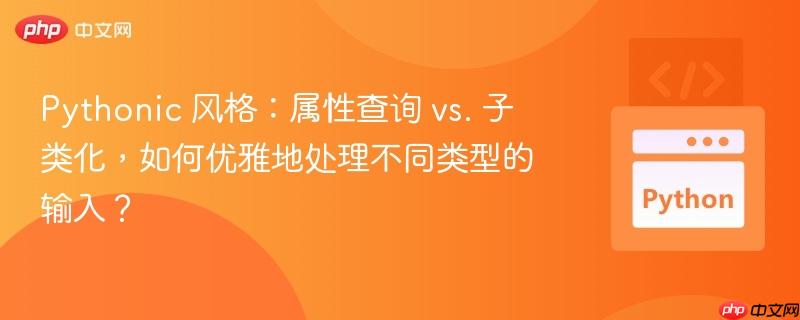
本文探讨了在Python中处理不同类型输入时,属性查询和子类化这两种方法的优劣。通过一个衰减epsilon值的示例,展示了如何将不同类型的输入统一转换为标准数据类型,从而实现更简洁、更易于维护的代码。最终推荐在函数或类中优先进行类型转换,以保持代码的一致性和可读性和灵活性。
在Python编程中,经常会遇到需要处理不同类型输入的情况。例如,一个函数可能需要接受一个数值或者一个实现了特定方法的对象。面对这种情况,我们通常有两种选择:一是通过属性查询(duck typing)来检查输入是否具有所需的方法,二是通过子类化来确保输入是特定类型的实例。那么,哪种方法更符合 Pythonic 的风格呢?
假设我们需要创建一个 DoSomething 类,该类接受一个 epsilon 参数,这个参数可以是一个浮点数,也可以是一个具有衰减方法的对象。我们希望在 DoSomething 类的 something 方法中调用 epsilon 的衰减方法。
以下是两种可能的实现方式:
立即学习“Python免费学习笔记(深入)”;
1. 使用属性查询:
class EpsilionWithDecay(ABC):
@abstractmethod
def decay(self):
...
def decay(ep):
if isinstance(ep, object) and hasattr(ep, 'decay') and callable(ep.decay):
ep.decay()
class DoSomething:
def __init__(self, epsilion):
self.epsilion = epsilion
def something(self):
# other code
# then call decay
decay(self.epsilion)
ds1 = DoSomething(0.2)
ds1.something()
ds2 = DoSomething(DecayingEpsilion(0.2))
ds2.something()2. 使用子类化:
class EpsilionWithDecay(ABC):
@abstractmethod
def decay(self):
...
def decay(ep):
if isinstance(ep, EpsilionWithDecay):
ep.decay()
class DoSomething:
def __init__(self, epsilion):
self.epsilion = epsilion
def something(self):
# other code
# then call decay
decay(self.epsilion)
ds1 = DoSomething(0.2)
ds1.something()
ds2 = DoSomething(DecayingEpsilion(0.2))
ds2.something()根据 "EAFP"(Easier to ask for forgiveness than permission)原则,Python 鼓励在使用一个对象之前先尝试使用它,如果出现错误再进行处理。但是,在处理不同类型的输入时,更好的做法是先将输入标准化为一种标准类型,然后再进行后续操作。
在这种情况下,我们可以创建一个 DecayingEpsilon 类,并在 DoSomething 类的 __init__ 方法中,将所有非 DecayingEpsilon 类型的输入转换为 DecayingEpsilon 类型的实例。
class DecayingEpsilon:
def __init__(self, value):
self.value = value
def decay(self):
# 衰减逻辑
self.value *= 0.9 # 示例:每次衰减 10%
print(f"Epsilon value decayed to: {self.value}")
class DoSomething:
def __init__(self, epsilon):
if not isinstance(epsilon, DecayingEpsilon):
epsilon = DecayingEpsilon(epsilon)
self.epsilon = epsilon
def something(self):
self.epsilon.decay()
ds1 = DoSomething(0.2)
ds1.something()
ds2 = DoSomething(DecayingEpsilon(0.2))
ds2.something()这种方法的优势在于:
在 Python 中处理不同类型的输入时,虽然属性查询是一种常用的方法,但更 Pythonic 的做法是先将输入标准化为一种标准类型。这种方法可以提高代码的清晰度、可维护性和类型安全性。在设计类和函数时,应该优先考虑类型转换,以保持代码的一致性和可读性。
以上就是Pythonic 风格:属性查询 vs. 子类化,如何优雅地处理不同类型的输入?的详细内容,更多请关注php中文网其它相关文章!

每个人都需要一台速度更快、更稳定的 PC。随着时间的推移,垃圾文件、旧注册表数据和不必要的后台进程会占用资源并降低性能。幸运的是,许多工具可以让 Windows 保持平稳运行。

Copyright 2014-2025 https://www.php.cn/ All Rights Reserved | php.cn | 湘ICP备2023035733号